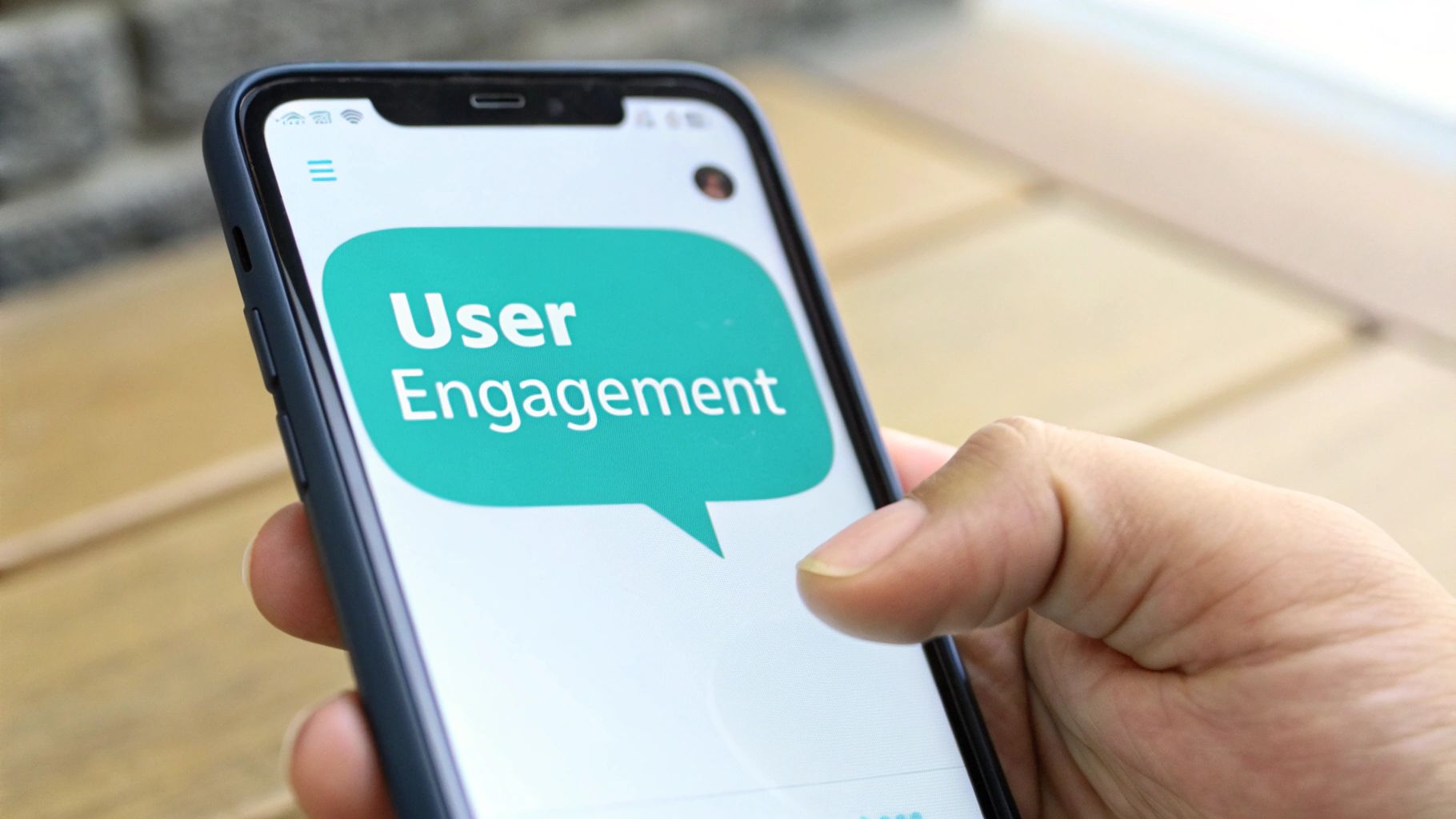Mastering Social Media Engagement Metrics: A Complete Guide to Performance Tracking
Transform your social media strategy with expert insights on engagement metrics that drive real results. Learn battle-tested approaches to measuring, analyzing, and improving your social media performance from industry veterans.

Mastering Social Media Engagement Metrics: A Complete Guide to Performance Tracking
Understanding Social Media Engagement Fundamentals
Social media has evolved into an essential business tool that goes far beyond basic content sharing. At its core is social media engagement - the genuine interactions and conversations between brands and their audiences. Building real connections requires more than collecting likes and followers. It's about creating meaningful discussions, responding thoughtfully to comments, and nurturing an active community around your brand.
Why Engagement Matters
When your audience actively engages with your content, it sends strong signals to platform algorithms about its value and relevance. This natural boost in visibility helps expand your reach to new potential customers. More importantly, authentic engagement creates lasting relationships. As people interact more with your brand, they're more likely to become loyal customers who advocate for your business to others.
Key Metrics for Measuring Engagement
To improve your social media performance, you need clear data on how well your content connects with followers. Here are the essential social media engagement metrics to track:
- Engagement Rate: Shows what percentage of your audience responds to your posts through likes, comments, or shares
- Reach: Measures how many unique users see your content across their feeds
- Likes, Comments, and Shares: Basic metrics that reveal which types of content resonate most with your followers
- Click-Through Rate (CTR): Tracks how often people click links in your posts to visit your website or landing pages
Recent data shows significant differences in engagement across platforms. According to 2024 statistics, Instagram achieves an average engagement rate of 3.50% based on reach, while Facebook averages 1.20%. For deeper insights, check out Social Media Reach Statistics. These numbers highlight why it's crucial to adapt your approach for each platform's unique audience and features. For platform-specific tips, see How to Master Twitter Engagement.
Essential Engagement Metrics That Drive Growth
Looking at raw numbers like likes and followers doesn't tell the full story of social media success. Smart brands focus on engagement metrics that show real business impact. By tracking several key indicators together, companies can see how well their social content resonates with audiences and drives meaningful results.
Key Metrics to Track
These essential metrics help paint a clear picture of your social media performance:
Engagement Rate: This shows what percentage of your audience takes action on your posts through likes, comments, or shares. It tells you if your content connects with followers - higher rates mean your posts hit the mark, while lower rates suggest room for improvement.
Reach: Tracking unique viewers helps you understand your content's visibility. The more people who see your posts, the better chance you have of growing your audience and building brand recognition.
Shares: When followers share your content, it signals they found it valuable enough to pass along to their network. Each share helps spread your message organically while validating your content quality.
Comments: Unlike simple likes, comments give you real feedback about what resonates. Reading and analyzing comments helps shape future content and catch any issues early.
Click-Through Rate (CTR): For posts aimed at driving website traffic, CTR shows how effectively your content motivates clicks. Low rates may mean adjusting your calls-to-action or content approach.
Understanding the Nuances of Engagement
Different types of engagement tell different stories about how people interact with your content. Basic metrics like likes show appreciation, while comments reflect deeper connection and provide actual feedback. Learn more about social media metrics to better understand these distinctions and use them to refine your strategy.
Setting Benchmarks and Targets
Tracking numbers alone isn't enough - you need clear goals to measure against. Look at industry averages and competitor performance to set realistic targets. This helps prove the value of your social media efforts and spot areas needing work. For platform-specific insights, check out guides like How to master Twitter Analytics.
Balancing Quantitative and Qualitative Insights
While hard data matters, don't ignore the human element. Pay attention to the tone of comments, overall sentiment, and context of conversations about your brand. Combining numbers with these softer insights gives you the full picture needed to make smart decisions and drive real growth through social media.
Mastering Engagement Rate Calculations

Getting a clear picture of how well your social media content performs starts with understanding engagement metrics. When you can turn raw numbers into meaningful insights, you're better equipped to refine your social media approach. Let's break down how to calculate engagement rates - the key measure of how your audience interacts with your content.
Calculating Your Engagement Rate
The basic engagement rate formula is straightforward: Take your total engagements (likes, comments, shares, etc.), divide by your total followers, and multiply by 100 to get a percentage. This gives you a clear baseline for measuring audience interaction. For a deeper dive into this topic, check out this complete guide to social media engagement rates.
Here are the key components to track:
- Total Engagements: Count every interaction - likes, comments, shares, saves, and reactions on your posts
- Total Followers/Reach: Your total follower count or the number of people who saw a specific post. For more metrics insight, see How to master Twitter Impressions
Different Approaches to Engagement Rate Calculation
You can measure engagement rates in several ways, depending on what you want to learn:
Engagement Rate by Reach (ERR): Divide total engagements by post reach and multiply by 100. This shows how engaging a specific post was to the people who saw it.
Engagement Rate by Followers (ERF): Divide total engagements by total followers and multiply by 100. This helps you assess your overall account performance.
Daily Engagement Rate (DER): Calculate average engagement for each day over a set period. This helps spot patterns and track how engagement changes over time.
Choose your calculation method based on your goals. Use ERR to evaluate individual posts, or ERF to understand your account's overall health.
Why Context Matters in Engagement Rate Analysis
While calculating engagement rates is simple, interpreting them takes more nuance. What counts as "good" engagement varies widely by industry, platform, and audience size. Small accounts with focused audiences often see higher engagement rates than large accounts with broader followings.
Different types of content naturally generate different levels of engagement too. A giveaway post might get lots of quick interactions, but that doesn't necessarily reflect your typical engagement levels. Keep these factors in mind when evaluating your social media performance - numbers alone don't tell the whole story.
Platform-Specific Engagement Optimization
Each social media platform has its own unique character and audience behaviors that require a customized approach. Success comes from understanding these differences and adjusting your content and measurement strategies accordingly, while keeping your brand identity consistent across platforms.
Tailoring Content for Each Platform
Different platforms call for different content styles to engage their audiences effectively. Instagram users respond best to polished visuals and quick video clips - the platform's 3.50% average engagement rate shows how well visual storytelling works here. Twitter works differently, favoring brief text updates and quick responses to trending topics. Learn more about maximizing your Twitter presence in our guide to How to master the best times to post on X (formerly Twitter).
Facebook audiences tend to engage more with longer posts that mix text and images while building community discussions. Over on LinkedIn, professional content like industry insights and career advice typically sees the strongest response, reflecting its business-focused user base.
Understanding Timing and Engagement Patterns
When you post can be just as important as what you post. Each platform has its own prime engagement windows that you'll want to target. For instance, Instagram typically sees highest activity during evenings and weekends, with users browsing through visual content. Twitter's rapid-fire nature means conversations happen throughout the day, requiring more frequent monitoring and responses.
Testing and Optimizing Across Platforms
The key to improvement is consistent testing and analysis. Try different approaches with your headlines, images, and calls-to-action to see what resonates most strongly. Track your social media engagement metrics carefully to identify what's working. This might mean shifting your posting schedule or experimenting with new content formats based on how your audience responds.
Maintaining Brand Consistency Across Platforms
While you should adapt your approach for each platform, your core brand identity needs to stay recognizable everywhere. Keep your key messages, visual style, and brand voice aligned across all channels - this builds familiarity and trust with your audience regardless of where they find you. Finding this balance between platform optimization and consistent branding is what drives real engagement and business results.
Making the Most of Social Media Analytics Tools

Picking the right tools to track your social media metrics is crucial for success, but it can feel daunting with all the options available. Let's break down how to build an analytics system that works for your needs and budget, starting with the basics and scaling up as needed.
Built-in Platform Analytics
Each major social platform comes with its own analytics dashboard. Facebook, Twitter, and LinkedIn all offer free built-in analytics that show you reach, engagement, and audience information. These tools give you essential data like how many people see your posts and who your followers are. For small businesses or those just starting out, these native tools provide solid insights without any extra cost.
Advanced Third-Party Tools
When you need deeper analysis across multiple platforms, third-party tools become valuable. These platforms offer specialized features like:
- Competitor tracking
- Sentiment analysis
- Custom report building
- Cross-platform data comparison
Some tools focus on specific areas - like monitoring influencer campaigns or tracking brand mentions online. You might find our guide to Top 10 LinkedIn Alternatives helpful for exploring professional networking tools. Choose platforms that match your specific goals rather than trying to use everything at once.
Creating Your Analytics System
Start simple with free platform tools to understand your basic performance metrics. As your needs grow, add targeted third-party tools that fill specific gaps in your analysis. This step-by-step approach helps you build a practical analytics system without wasting resources on features you won't use.
Making Reporting Easier
Most modern analytics tools include features to save you time on routine tasks. Set up:
- Regular automated reports
- Custom alerts for important changes
- Combined dashboards showing data from multiple sources
This automation frees up your time to focus on understanding trends and making better decisions. Instead of spending hours gathering data, you can concentrate on what the numbers mean for your strategy and how to improve your results.
Combine these tools thoughtfully, focusing on metrics that matter to your goals, and you'll be able to make smarter decisions about your social media presence. Remember to regularly review which tools you're using and adjust as your needs change.
Converting Metrics Into Strategic Success

Simply gathering social media engagement data isn't enough - you need to turn those numbers into concrete actions that boost your results. Smart businesses closely examine their metrics to understand what their audience wants, adjust their approach based on real feedback, and make progress toward specific goals. Let's explore practical ways to connect your data to meaningful business outcomes.
Identifying Meaningful Patterns in Your Data
Look for clear trends in how your content performs over time. Pay attention to which days and content types consistently get more or less engagement from your followers. For example, if your video posts regularly outperform text updates, that's valuable insight for planning future content. Focus especially on metrics like shares and comments, since these show what topics really spark discussion among your audience. The key is to track performance consistently and be willing to test new approaches.
Spotting Opportunities and Fixing Problems Early
Regular metric analysis helps you catch both positive and negative trends quickly. When engagement suddenly spikes on a particular type of post, you can create more similar content while interest is high. On the flip side, if you notice engagement dropping off, investigating right away lets you address issues before they become bigger problems. Sometimes a simple tweak to posting time or content mix can get things back on track.
Making Data Clear and Compelling
Raw numbers alone won't convince anyone - you need to package metrics in a way that tells a clear story. Focus on creating simple visual reports that highlight key trends and show exactly how your social media efforts connect to business goals. Well-designed reports make it much easier to get support for new initiatives and justify continued investment in social media.
Frameworks for Strategic Decision-Making
Two proven frameworks can guide how you analyze and act on your social media data. The SMART framework helps you set concrete goals that are Specific, Measurable, Achievable, Relevant, and Time-bound. This ensures your social media work drives real results. The SWOT analysis examines your Strengths, Weaknesses, Opportunities, and Threats to identify where you can improve and gain advantages over competitors. Together, these tools help you make strategic choices based on data.
Ready to take your social media strategy to the next level with AI? Qura helps you create engaging content, automate responses, and analyze performance so you can focus on building real connections with your audience. Visit us today to start your free trial.